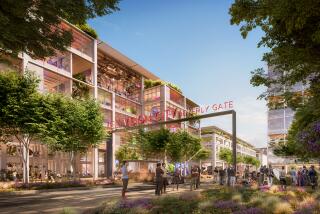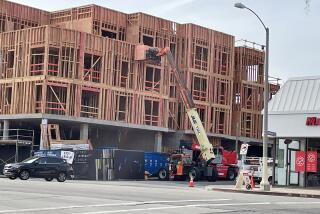Review Casts Fresh Doubts on $222-Million Ventura Boulevard Project : Traffic: Study questions cost and timing of work. Some proposed improvements are blocked by buildings.
- Share via
A review of traffic improvements planned under an ambitious $222-million project for improving Ventura Boulevard has raised questions that authorities say could alter the cost, timing and nature of the work.
Critics say the review by city transportation officials could undermine a key component of the Ventura Boulevard Specific Plan, designed for the next 20 years to tame unruly growth, ease traffic and beautify the landscape along the historic boulevard’s 17-mile course through the San Fernando Valley.
The study followed concerns by members of a public board monitoring implementation of the Ventura Boulevard project that 42% of the lane improvements planned are blocked by buildings.
The issue, argued largely behind closed doors, has reopened debate over the plan, which has been controversial since its inception in 1991.
A key component is a project to ease the flow of east-west traffic along the heavily congested boulevard by creating right turn lanes and other improvements at 28 key intersections. At those intersections, 208 lane improvements are planned. But the budget and finance subcommittee of the 13-member Ventura Boulevard Specific Plan Review Board, found that 88 of those improvements are blocked by buildings.
The plan assumes that these buildings would be removed over the next 20 years and replaced with structures that would accommodate the traffic improvements, city officials said.
“We expect development to go forward over the next 20 years and we expect the plan to accommodate that development,” said Allyn Rifkin, principal transportation engineer for the city Department of Transportation.
The question of buildings blocking some of the planned street improvements was raised when the plan was being developed, Rifkin said, and has been accounted for. But critics said the review under way shows the need for considering alternatives, such as car-pooling and shuttle buses, to pick-and-shovel traffic improvements.
“We’re looking for ways to make this work, and if that means going back to the drawing board, that’s what we’ll do,” said Jeff Brain, chairman of the budget and finance subcommittee. Brain, president of the Sherman Oaks Chamber of Commerce, has been a critic of several elements of the project.
Aides to several City Council members said the review may force changes.
Cindy Miscikowski, planning deputy for City Councilman Marvin Braude, said officials knew some of the sites of planned improvements were blocked when the plan was being considered.
“That was understood when the plan was adopted,” Miscikowski said. “But we were basing everything on a very rapid pace of growth when lots of one-, two- and three-story buildings were being torn down.”
Miscikowski said growth has not matched projections. She said the review will show how many improvements are blocked by larger, newer buildings that are likely to remain, as opposed to those that may be torn down.
“It’s going to be more interesting when we know what’s there,” she said. “Depending on that, there might have to be some re-evaluation of the foundation of the plan.”
Vivian Rescalvo, planning deputy for City Councilman Zev Yaroslavsky, agreed.
“It was just assumed that everything would be demolished and built all over again,” she said. “So maybe the focus of the plan will shift.”
Rifkin said the plan’s response to lack of development is automatic.
“If the redevelopment doesn’t take place, then there are no additional trips generated and the improvements won’t be needed.”
But regional growth means traffic will continue to increase along the boulevard, whether or not new development occurs at the intersections, Brain contended. And if intersections cannot be widened, then merchants should not be charged for improvements that cannot be made, Brain said.
Last month, the City Council gave merchants along the boulevard four more years to begin paying about $13 million in fees assessed so far to help fund the massive improvements.
Those charges, or trip fees, have been assessed based on a complicated formula designed to gauge the impact of additional traffic, measured in trips.
“We don’t need to be raising trip fees to cover the cost of intersections that can’t be widened,” Brain said.
Ken Bernstein, president of the review board, said if the review shows that an error was made in planning, it may be for the best.
“It’s a problem--and it’s an opportunity,” he said. “Many of us on the board feel there may be more cost-effective ways of improving the flow of traffic. We need to re-examine some of our assumptions and make sure we’re going about it in the right way.”
He said alternatives to lane widening such as car-pooling and providing shuttle buses may be a cheaper way of easing the flow of traffic on the boulevard.
More to Read
Sign up for Essential California
The most important California stories and recommendations in your inbox every morning.
You may occasionally receive promotional content from the Los Angeles Times.











